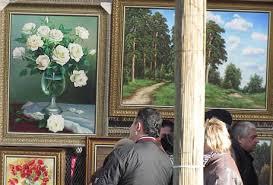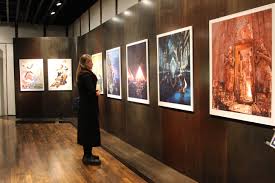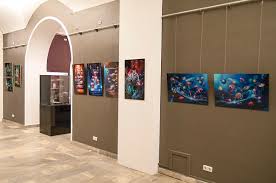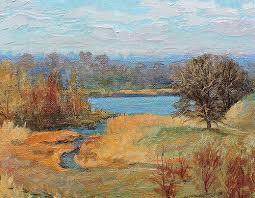HISTORY OF LANDSCAPE GENRE DEVELOPMENT (part 1)
 Translated from French, the word “landscape” (paysage) means “nature”. This is what the genre is called in fine art, the main task of which is the reproduction of natural or human-modified nature.
Translated from French, the word “landscape” (paysage) means “nature”. This is what the genre is called in fine art, the main task of which is the reproduction of natural or human-modified nature.
In addition, the landscape is a specific work of art in painting or graphics, showing the viewer nature. The “hero” of such a work is a natural motif or a natural motif invented by the author.
Elements of the landscape can be found already in cave art. In the Neolithic era, primitive masters schematically depicted rivers or lakes, trees and stone blocks on the walls of caves. On the Tassilin-Ager plateau in the Sahara, drawings were found with scenes of hunting and driving herds. Next to the figures of animals and humans, the ancient artist schematically painted a simple landscape, which does not give the opportunity to specify the scene. In the art of the Ancient East and Crete, a landscape motif is a rather common detail of wall paintings. So, near the village of Beni Hassan in Central Egypt, rock tombs of ancient Egyptian rulers who lived in the 21-20 centuries BC were found One of the many frescoes covering the walls of the burial chambers depicts a wild cat hunting in dense thickets. Among the murals of the halls of the famous Knossos palace on the island of Crete, a mural was discovered called by the researchers “Partridge in the Rocks”.
In the ancient Roman city of Stabia, which was destroyed, like Pompeii, during the eruption of Vesuvius, among the other paintings found in one of the patrician houses, the fresco “Seaport” stands out, which is a real seascape.
As an independent genre, the landscape appeared already in the VI century in Chinese art. The paintings of medieval China very poetically convey the surrounding world. The inspired and majestic nature in these works, made mainly by ink on silk, appears as a huge universe without borders. The traditions of Chinese landscape painting have had a great influence on Japanese art. Unfortunately, the scope of our publication does not allow us to tell in detail about the landscape painters of China and Japan – this is a topic for a separate book.
In Europe, landscape as a separate genre appeared much later than in China and Japan. In the Middle Ages, when only religious compositions had the right to exist, the landscape was interpreted by painters as an image of the characters’ habitat.
A large role in the formation of landscape painting was played by European miniaturists. In medieval France, at the courtyards of the Dukes of Burgundy and Berry in the 1410s, the talented illustrators of the Limburg brothers worked – the creators of charming miniatures for the duke of Berry’s oracle. These graceful and colorful drawings, telling about the seasons and the corresponding field work and entertainment, show the viewer the natural landscapes made from the workshop for that time by transmitting perspectives.
A pronounced interest in the landscape is noticeable in the paintings of the Early Renaissance. And although artists still very ineptly convey space, cluttering it with landscape elements that are not compatible with each other in scale, many paintings indicate the desire of painters to achieve a harmonious and holistic image of nature and man. This is the painting “Procession of the Magi” (first half of the 15th century, Metropolitan Museum of Art, New York) by the Italian master Stefano di Giovanni, nicknamed Sasetta.
A significant step forward in the development of landscape painting was the 15th-century Swiss artist Conrad Witz, who showed in his composition on a religious plot a specific area – the shore of Lake Geneva.



